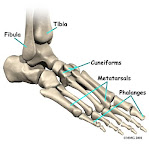Gout Symptoms Cures
Intercritical Gout:
There is a Gout symptom free period after the first attack. Eventually this phase is interrupted by the recurrence of acute attacks.
Onset of attacks:
The second attack usually occurs within one year from the first, although it may be delayed for 5-10 years.
Treatment:
Prevent by identifying and correcting the cause of increased uric acid OR by administering drugs that inhibit the synthesis of urate or increase its excretion.
Low dose NSAIDS as mentioned before may be effective but carries a higher risk of side effects.
Uricosurics – Probenecid and Sulfinpyrazole are preferred for underexcreters. These meds work by blocking the reuptake of urate by the kidneys therefore it is easily excreted. Probenecid is given initially in two oral doses of 250 mg for 1 week, and then increased to 500 mg twice daily every 1-2 weeks until serum uric acid level drops < 6 mg/dL (titrate to 1.5 g/day). Sulfinpyrazole is given initially in two daily doses of 50 mg, then increased by 100 mg weekly (titrate to 200 mg/day).
Xanthine oxidase inhibitor – Allopurinol blocks the final step in uric acid synthesis. It may be used for both underexcreters and overproducers. Allopurinol is given initially in a daily dose of 100-300mg/day, and then increased in weekly increments if needed. The main adverse effect is a rash which usually subsides with a lower dose.
Other drugs that increase uric acid excretion:
Losartan (Cozaar) – this is a good choice if patient is also hypertensive. This agent lowers serum uric acid levels by blocking its reuptake by the kidneys, therefore it is more easily excreted.
Fenofibrate (Tricor) – this is a good choice if patient also has high triglycerides. This agent lowers uric acid levels by increasing renal clearance.
Febuxostat is an investigational drug which is an alternative to Allopurinol. It works the same way although it may be more effective agains gout symptoms.
Gout Symptoms:
This may occur if gout and hyperuricemia go untreated for many years.
The constant increased levels of uric acid lead to development of tophi in the synovial, olecranon bursae, and other periarticular locations.
Eventually the cartilage may be destroyed and the joint may become deformed.
Allopurinol and Probenecid may be given in combo to treat severe situations.
The treatments for gout symptoms unfortunately are not normally used in senior citizens because of the increased risk of GI ulcers and cardiovascular effects….Although in the case of Gout Symptoms the benefit of treatment outweighs the risk.
jueves, 28 de febrero de 2008
Gout Symptoms & Treatments
Gout Symptoms mostly effects men (95% of cases), and most women that do experience gout are postmenopausal. Because uric acid levels up to 13 mg/dl in men and 10 mg/dl in women
The mean age at disease onset is 47 years old.
Risk of developing gout symptoms increases as the serum uric acid level rises (>7 mg/dl).
Gout has a familial tendency most of cases take place in family members
What causes Gout Symptoms
Primary hyperuricemia and gout may result from a defect in purine metabolism or uric acid excretion. The increase in uric acid levels can be caused by two different things:
Overproduction synthesize abnormally high amounts of uric acid and.
Underexcretion synthesize normal amounts of uric acid but they do not excrete it as well as they should.
Secondary hyperuricemia and gout develop as a result of another disease or as a result of drug therapy. Such us Hematologic causes, Chronic renal failure, etc.
GOUT ARTHRITIS:
Presentation of gout symptoms is characterized by painful arthritic attacks of sudden onset.
Gout Symptoms & Signs:
Initial attack is sudden, usually occurring at night or in early morning.
Affected joints become hot, swollen, and extremely tender.
The mean age at disease onset is 47 years old.
Risk of developing gout symptoms increases as the serum uric acid level rises (>7 mg/dl).
Gout has a familial tendency most of cases take place in family members
What causes Gout Symptoms
Primary hyperuricemia and gout may result from a defect in purine metabolism or uric acid excretion. The increase in uric acid levels can be caused by two different things:
Overproduction synthesize abnormally high amounts of uric acid and.
Underexcretion synthesize normal amounts of uric acid but they do not excrete it as well as they should.
Secondary hyperuricemia and gout develop as a result of another disease or as a result of drug therapy. Such us Hematologic causes, Chronic renal failure, etc.
GOUT ARTHRITIS:
Presentation of gout symptoms is characterized by painful arthritic attacks of sudden onset.
Gout Symptoms & Signs:
Initial attack is sudden, usually occurring at night or in early morning.
Affected joints become hot, swollen, and extremely tender.
Suscribirse a:
Comentarios (Atom)

